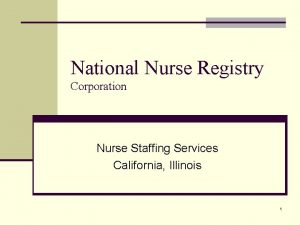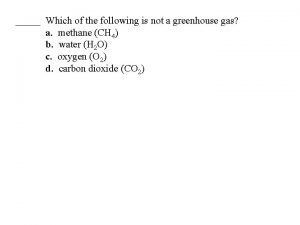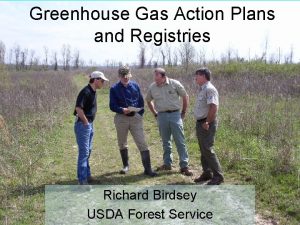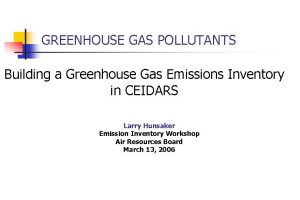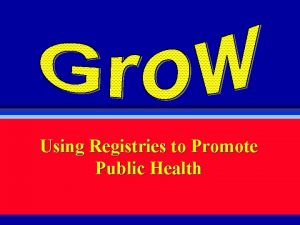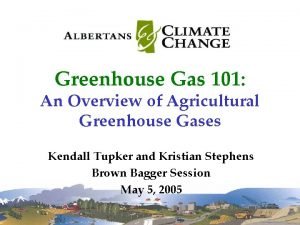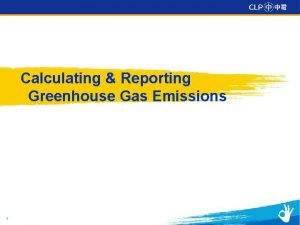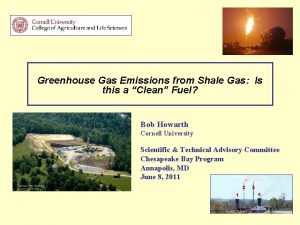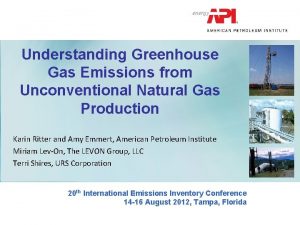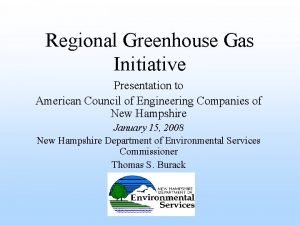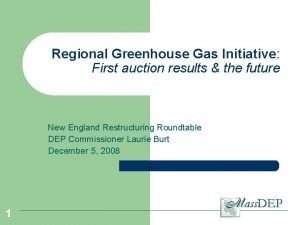Greenhouse Gas Registries and the Regional Greenhouse Gas











- Slides: 11

Greenhouse Gas Registries and the Regional Greenhouse Gas Registry (RGGR) Western Regional Air Partnership Information Sharing Meeting on Climate Change Santa Fe, NM – August 25 -26, 2005 Ken Colburn Center for Climate Strategies (CCS) kcolburn@symbioticstrategies. com 617 -784 -6975

GHG Registry Evolution NH 1999 WI 2000 CA 2000 ? • Baseline protection (vs. “no good deed goes unpunished”) • Encourage early reductions • Start learning to quantify GHGs, do inventories, etc. • Multiple pollutants

Idea Spread, Not Surprisingly • ED & Environment Resources Trust • Emissions brokers (CO 2 e, Evolution, Nat. Source) • Other states • Also – EU National Registers under Kyoto • Regional Greenhouse Gas Registry (RGGR) • CCX – a prospective “trading floor” • “New & improved” 1605 b (? ) … so has much confusion

Voluntary & Mandatory: Much Different Animals • Voluntary: Registry provides a central, independent repository for credible information about emissions activities (e. g. , for recognition, encouragement, baseline protection) • Mandatory & Cap and Trade: Registry performs a critical data management and accounting role and serves as a ledger of all transactions; information = $ / enforcement

Regional Greenhouse Gas Registry (RGGR) • NEG-ECP Plan called for developing a regional “emissions trading registry, and methods for baseline creation and credit generation” to – (a) provide baseline protection and – (b) gain experience in certifying credits and trading regionally • NESCAUM started on a regional voluntary registry in 2003, coordinating with major existing efforts – WRI / WBCSD GHG Protocol – CCAR • RGGI changed all that (regulatory driver) – Voluntary, Mandatory, & Emissions/Allowances Tracking – Facility-level data; Enforcement quality data required – Data custody & storage issues; offsets, etc.

Regional Greenhouse Gas Registry (RGGR) Trying to fill three “Policy Spaces” GHG Registry (e. g. , RGGR) 1 Entity-wide Voluntary Projects (Offsets) 2 Mandatory Reporting Emissions Tracking Regulatory 3 Cap & Trade (RGGI) Allowance Tracking Mechanism: Multi-state MOU or through a new regional organization

Complex: Not to Be Entered Into Lightly (1) • • • Function & Purpose Design components (sectors, etc. ) Geographical boundaries (state, nation, globe) Organizational boundaries (entity, facility, …) Ownership / control – Owner vs. operator – Minority ownership / consolidation • Gases covered • Base year • Offsets / project-based (never been done)

Complex: Not to Be Entered Into Lightly (2) • Operational boundaries – Sources covered – Direct & indirect emissions (upstream) • • Frequency of reporting Verification (3 rd party, certification) De minimis emissions Quantification requirements / tools Software; data storage & management Enforcement Public access / transparency

Good News: Need Not Fear • Lots of good information now, and “marketplace of ideas” about registries is rapidly converging • EU Emission Trading Scheme will work out many remaining kinks – e. g. , Legal, financial, & operational issues • Compass points clearly toward mandatory U. S. programs (has design ramifications) – Bingaman-Domenici “Sense of the Senate” Resolution • Quantification tools & approaches are rapidly becoming standardized (WRI, ISO, etc. ) • Not “rocket science”

Registries: Other Thoughts • Concern: Interest may be eclipsing capacity – Not much pre-existing institutional capacity – Only significant funding source is the states themselves – Deadlines (e. g. , CT – 1/1/2006) looming • Advance or complicate federal action? – – – Both, but mostly spur it Sources will seek greater consistency (e. g. , federal) Will help build toward a market International linkages may impact intransigence Future states will have precedent, rationale, and a better path to follow • Suggestion: Don’t look to 1605(b)… – Recent improvements, but still several fatal flaws

Key Conclusions • Registry / Tracking capability is vital to the success of future regulatory climate efforts by states – Many non-regulatory efforts available – A key part of the GHG “learning curve” • Bottom line for states: Proceed, but do so carefully and collaboratively – Complex but doable – Ideal topic for multi-state collaboration
 Nurse registries in california
Nurse registries in california Which of the following is not a greenhouse gas?
Which of the following is not a greenhouse gas? Hát kết hợp bộ gõ cơ thể
Hát kết hợp bộ gõ cơ thể Lp html
Lp html Bổ thể
Bổ thể Tỉ lệ cơ thể trẻ em
Tỉ lệ cơ thể trẻ em Chó sói
Chó sói Chụp phim tư thế worms-breton
Chụp phim tư thế worms-breton Bài hát chúa yêu trần thế alleluia
Bài hát chúa yêu trần thế alleluia Các môn thể thao bắt đầu bằng tiếng nhảy
Các môn thể thao bắt đầu bằng tiếng nhảy Thế nào là hệ số cao nhất
Thế nào là hệ số cao nhất Các châu lục và đại dương trên thế giới
Các châu lục và đại dương trên thế giới
